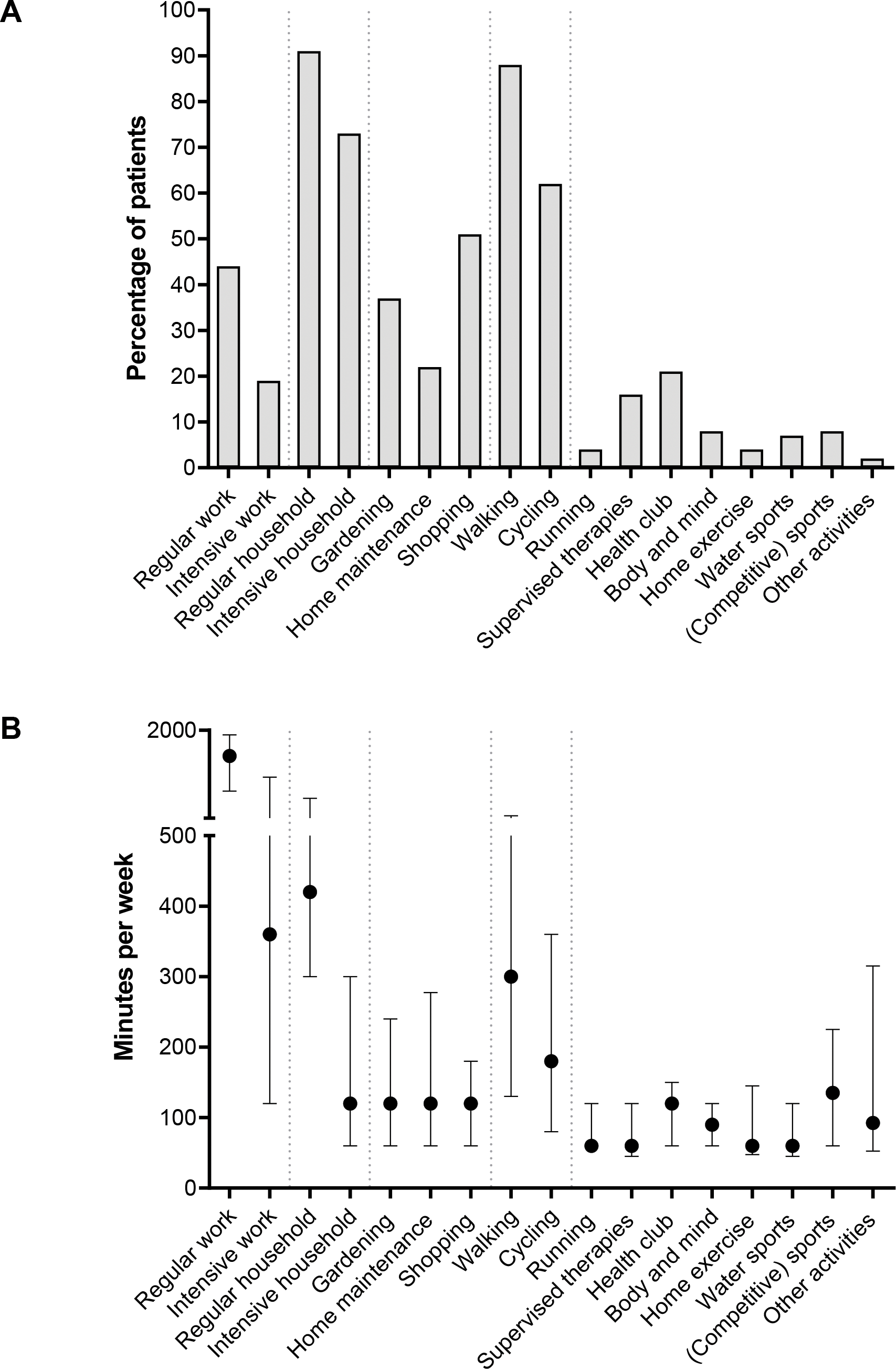

Background: The EULAR recommendations on lifestyle behaviors and work participation for patients with rheumatic and musculoskeletal diseases (RMDs) state that regular exercise is beneficial for many health outcomes. Regular physical activity (PA) has beneficial effects on pain, function and health-related quality of life (HR-QoL). Physical inactivity should be avoided and it is recommended to perform both aerobic and strengthening activities. Importantly, exercise is safe to perform and it is never too late to start exercising [1]. In Sjögren’s disease (SjD), officially licensed treatment options are limited, which makes optimizing lifestyle behaviors including physical activity maybe even more important. With the modified Short QUestionnaire to ASsess Health enhancing physical activity (mSQUASH), it is possible to gain more insight in the type, duration, frequency and intensity of PA performed by patients with SjD [2]. This information can help increasing self-awareness, identifying areas for improvement and it can give inspiration for creating personalized exercise programs in patients with SjD.
Objectives: To investigate the types of PA performed, how many patients complied with the World Health Organization (WHO) PA recommendations and the association of PA levels with HR-QoL in patients with SjD.
Methods: Consecutive patients from the REgistry of Sjögren’s disease LongiTudinal (RESULT) cohort were included. The mSQUASH was used to determine the types of PA and compliance with the WHO PA recommendations, consisting of aerobic and muscle strengthening activities, in combination with functional balance activities for adults aged ≥65 years. The aerobic component of the WHO guideline was fulfilled if patients engaged in ≥150 minutes of moderate-intensity PA, ≥75 minutes of vigorous-intensity aerobic PA, or a combination of both. For the muscle strengthening (activities that involve two major muscle groups, at least 2 days a week) and functional balance (at least 3 times per week) components of the WHO guideline, only the activities reported in the sports and exercise domain were taken into account. The 36-item Short Form health survey (SF-36) was used to measure the HR-QoL, filled out at the extensive RESULT visits. The associations between PA levels and HR-QoL domains were analyzed using linear regression, including correction for potential confounders.
Results: In total, 245 patients with SjD were included with median age of 57 years (IQR 46-68), 87% female, median disease duration of 10 years (7-16), median BMI of 24.4 (22.1-28.7), median ESSPRI of 6 (5-7), median ESSDAI of 4 (2-6), and 38% with current immunosuppressive medication use. Most frequently reported PA were household activities (91%), walking (88%) and cycling (62%). In total, 44% of the patients reported activities at work (paid/unpaid) or school/study. Of the patients ≤65 years of age, 61% worked with a median of 1560 minutes a week (IQR 975-1920), which corresponds to a median 26-hour work week. Sports and exercise were performed by 55% of patients; most often fitness, physiotherapy/sport, group lessons, yoga and swimming (Figure 1). Patients performed most minutes in moderate PA compared to the minutes light and intense PA (median 1680 (IQR 720-2568) vs. 480 (IQR 240-840) and 0 (IQR 0-0), respectively). In the total group of patients (n=245), 92% fulfilled the aerobic PA component and 29% fulfilled the muscle strengthening component. Of patients aged <65 years (n=170), 29% fulfilled the WHO PA recommendations: 96% aerobic and 29% muscle strengthening activities. Of patients aged ≥65 years (n=75), 8% fulfilled the WHO PA recommendations: 84% aerobic, 39% muscle strengthening and 8% functional balance activities. In total, 147 SjD patients filled out the SF-36. Patients scored the lowest in the domains general health, vitality and role limitations due to physical health. In univariable linear regression, all SF-36 domains showed significant associations with mSQUASH, with the strongest associations for the physical-related domains: physical functioning (R 2 =0.19) and role limitations due to physical health (R 2 =0.17). The associations for physical functioning, role limitations due to physical health, vitality and bodily pain remained statistically significant after correcting for age, sex, BMI, ESSPRI, ESSDAI and current immunosuppressive medication use (Table 1).
Conclusion: Most patients with SjD performed aerobic PA, but there is room for improving the muscle strengthening and functional balance components from the WHO PA recommendations. Higher levels of PA were significantly associated with better HR-QoL.
REFERENCES: [1] Gwinnutt et al. Ann Rheum Dis 2023;82:48–56.
[2] Ausma et al. Clin Exp Rheumatol. 2024 Dec 10. Online ahead of print.
Types of PA performed by the 245 patients with SjD (A) and minutes per week in the subgroup of patients performing these PA (B)

Physical activity (mSQUASH: minutes a week of moderate and vigorous PA) in relation to HR-QoL (SF-36) in 147 patients with SjD
| SF-36 domains | mSQUASH | mSQUASH corrected for confounders* | ||||
|---|---|---|---|---|---|---|
| R2 | B (95%CI) | p-value | R2 | B (95%CI) | p-value | |
| Physical functioning | 0.186 | 24 (16-32) | <0.001 | 0.248 | 20 (10-31) | <0.001 |
| Role physical | 0.171 | 21 (13-29) | <0.001 | 0.292 | 22 (13-31) | <0.001 |
| Social functioning | 0.036 | 11 (2-20) | 0.002 | 0.208 | 10 (-1-20) | 0.068 |
| Role emotional | 0.053 | 10 (3-18) | 0.006 | 0.196 | 7 (-1-15) | 0.075 |
| Bodily pain | 0.077 | 16 (7-25) | <0.001 | 0.208 | 13 (2-23) | 0.024 |
| Vitality | 0.063 | 16 (6-26) | 0.002 | 0.232 | 16 (5-28) | 0.006 |
| Mental health | 0.190 | 14 (2-27) | 0.022 | 0.205 | 7 (-2-25) | 0.084 |
| General health | 0.043 | 13 (3-24) | 0.012 | 0.205 | 10 (-1-21) | 0.085 |
* age, sex, BMI, ESSDAI, ESSPRI and current immunosuppressive medication use
Acknowledgements: The authors would like to thank all patients who participate in the RESULT cohort.
Disclosure of Interests: None declared.
© The Authors 2025. This abstract is an open access article published in Annals of Rheumatic Diseases under the CC BY-NC-ND license (